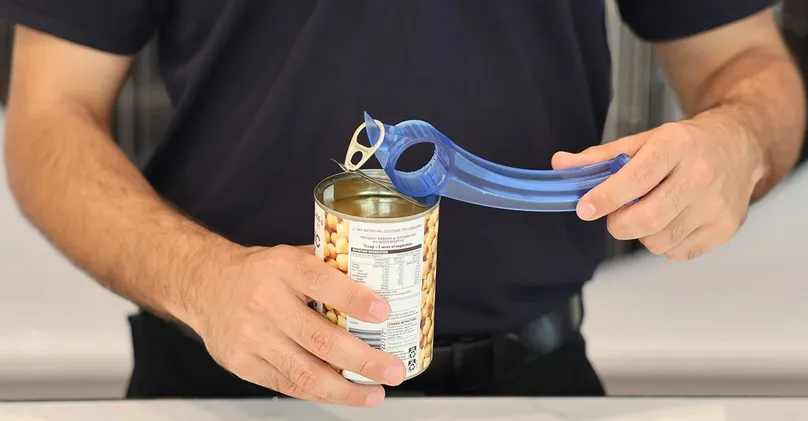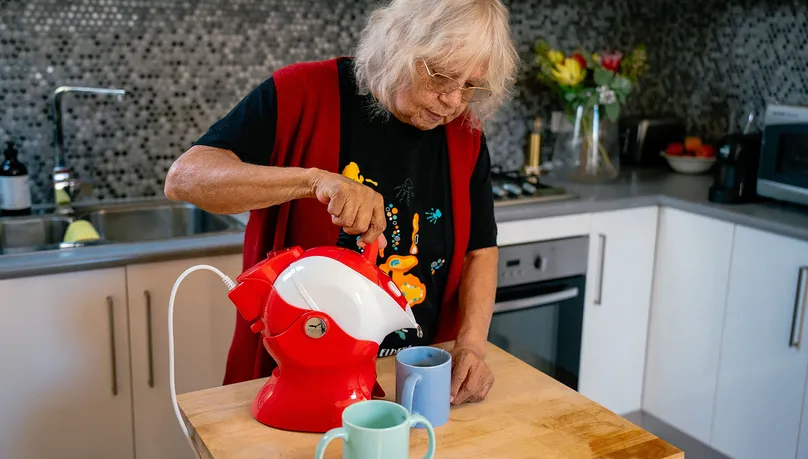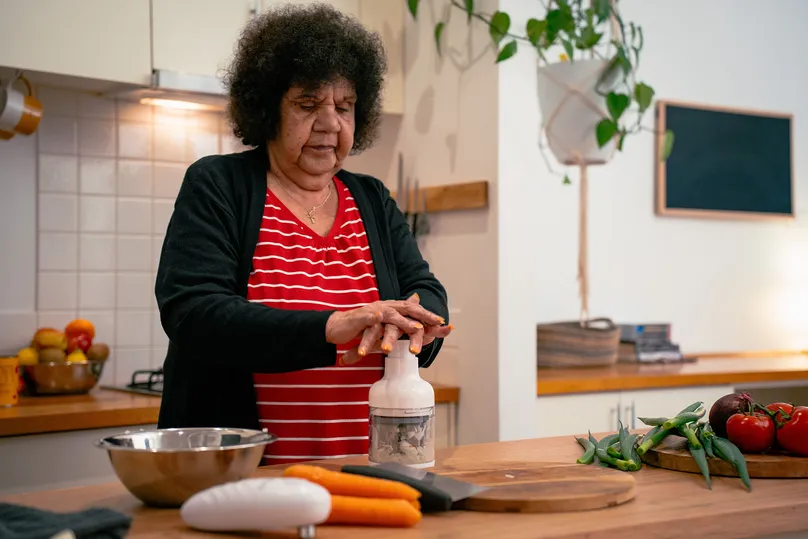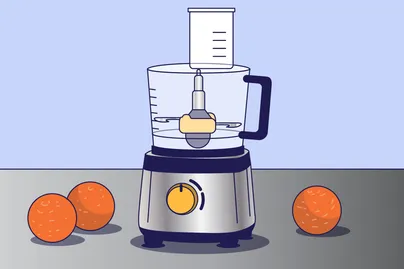Assistive products, such as kitchen appliances, can make it easier to cook, prepare food, and clean up after.

Do you have limited mobility or dexterity in your hands? Or pain from doing kitchen tasks? Thankfully, there's a vast range products that can help make your daily kitchen chores easier and safer.
Choosing the right kitchen appliances can feel overwhelming. There are so many options. However, it’s important to choose an assistive product that can do everything you want it to do. You can make your life easier by finding the right tools for you.
Assistive products for food prep
Arthritis or other conditions can cause reduced hand strength, pain, or limited mobility in your hands and wrists that make kitchen work difficult.

If you're generally finding it difficult to prepare food – these products might help you out:
Bottle, can, and jar openers: You can find a range of adaptive bottle, can, or jar openers that are designed to help provide independence in the kitchen. One touch automatic openers simplify this task even further, requiring minimal effort and reducing strain on the hands.
Kettle tippers: Kettle tippers and tipping kettles aid in safely pouring hot water without the need to lift heavy kettles, reducing the risk of spills and burns.

Adaptive peelers and electric peelers: Have an ergonomic design to help reduce pain and effort when peeling fruit and vegetables.
Food wands: Help to quickly blend or chop food. Some food wands come with additional fittings that let you grind and chop, like a mini food processor. They can be used one-handed or by someone with a hand tremor.

Adaptive cutting boards: Designed with features like non-slip bases and stabilising elements to assist with one-handed food preparation.
Ergonomic utensils: Adaptive cutlery, saucepans, and other tools and utensils with larger, padded handles alleviate pressure on joints, making tasks like stirring and flipping easier if you have arthritis. Non-slip products like scoop plates can help you avoid spills.
Helpful cooking appliances

There are many products that can make cooking easier if you:
- Find it hard to cook using a standard stovetop
- Can’t stand for long
- Experience fatigue and pain
- Have limited dexterity
- Have weakness in your arms and hands
Here are some useful cooking appliances to consider:
Air fryers: A popular way of heating and frying foods using up to 75% less oil. They can also roast, bake, or reheat food.
Portable induction cookers: Easy to store and move around. These can also be safer than gas stovetops, with no open flames and a reduced risk of burns.
Multipurpose benchtop convection ovens: These combine several cooking functions in one appliance. They also reduce the need to bend or carry heavy dishes between the oven and your cooking space. Choosing multipurpose products like this can help reduce clutter and simplify your cooking experience.
Electric pressure/slow cookers: Many models include built-in timers and other safety features, making them a convenient, lower-risk option for preparing meals.
Cooking food processors (like the Thermomix): While they can be more expensive, these appliances are highly versatile. They can chop, stir, cook, and blend all in one.
Dishwashing products
Benchtop dishwashers: Can be mounted on the kitchen benchtop. This makes them easy to access and reduces the need for bending and reaching. They can also be installed under a bench.
Dish drawers: Are small dishwashers that can be installed at a height that suits you. A dish drawer enables easy standing access or access for a seated user.
Clean/dirty dishwasher magnets: Can help you keep track of what's been washed already.
What to consider before you buy
Here are some questions to ask before choosing from the extensive range of functional tools that are available:
- Storage: Ensure the appliance fits within your kitchen space and is easily accessible.
- Weight: Choose lightweight appliances that are easy to handle, especially when full.
- Functionality: Choose products that meet your specific needs and have controls you can see and use easily.
- Cleaning: Select appliances that are easy to disassemble and clean, with dishwasher-safe parts if possible.
- Safety features: Look for appliances with non-slip surfaces as bases, automatic shut-off functions, and other safety enhancements. Check the manufacturers precautions and consider if you need to buy accessories to enhance the product's safety. (e.g. Does the appliance have exposed sharp edges? Can you cover sharp edges with protective strips?)
An occupational therapist (OT) can provide personalised recommendations based on your unique requirements.
An OT can help you
- Adapt everyday tasks to help you stay independent and improve your quality of life
- Find products that assist you to cook and clean up with greater ease
- Protect your joints and manage any pain you might experience
Find an OT in your local area with the search tool on the Occupational Therapy Australia website.
Additional resources
Want to find out what products are out there? Here are some product directories to peruse:
Want to know what others think of a product? Here are some useful review websites:
Need some help? Call us for free today on 1800 951 971.
References
Arthritis Australia. (2024, May). Fatigue and arthritis (AA025-05/24 ISS1). https://arthritisaustralia.com.au/wordpress/wp-content/uploads/2024/06/4042-AA-Info-Sheet-Fatigue-and-arthritis-AA025-05-24-ISS1.pdf
Indigo. Kitchen aids. National Equipment Database. https://askned.com.au/kitchen-aids
How to use this information
LiveUp provides free information to help you make informed decisions about your health. This information is for general and educational purposes only, is not intended to provide a comprehensive guide, and does not replace medical advice. Everyone is different, so some of these tips may work better for you than others. You should use your own judgment and seek medical advice when applying this information to yourself, to determine if it is suitable in your circumstances. Your use of, or reliance on, this information is solely at your own risk. Independent Living Assessment Incorporated is not responsible or liable for any injury, loss, or damage caused as a result of your use of, or reliance on, this information.
Download and print this article:
You can print out the PDF and stick it to your fridge or file away the tips to revisit at a later time.

Read more Safety articles
Did you enjoy this article? You may also like reading similar healthy ageing articles.
See all Safety articles

